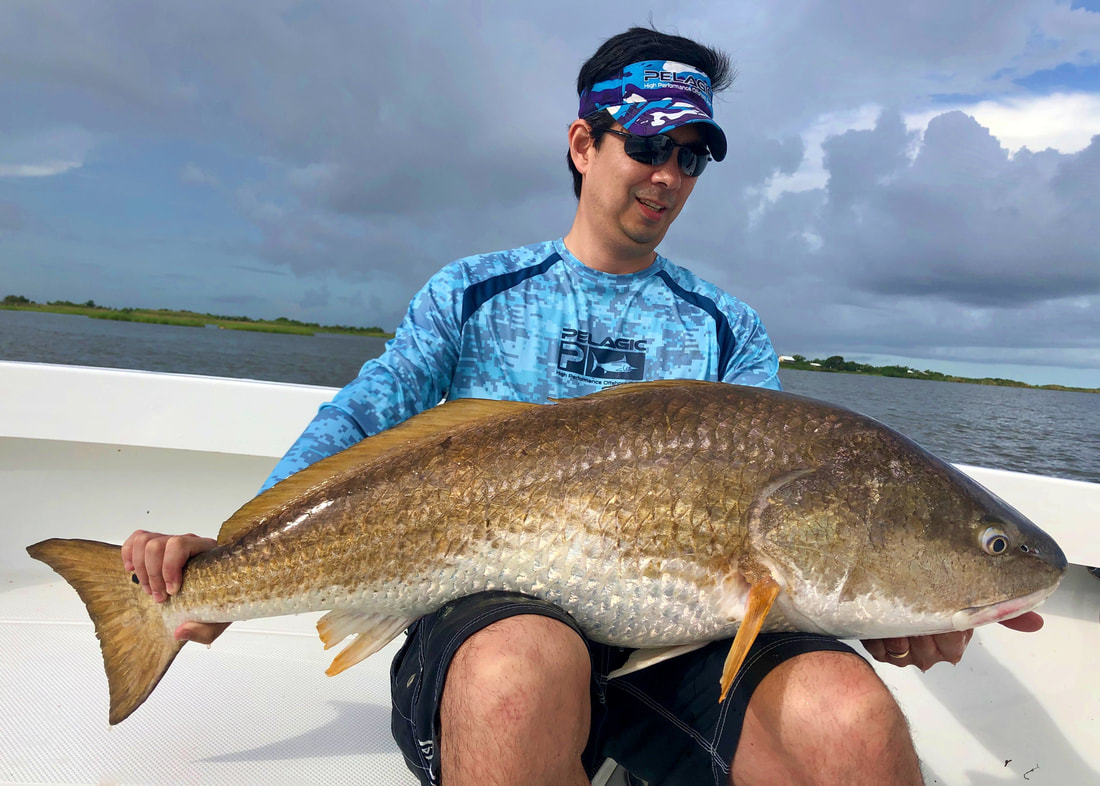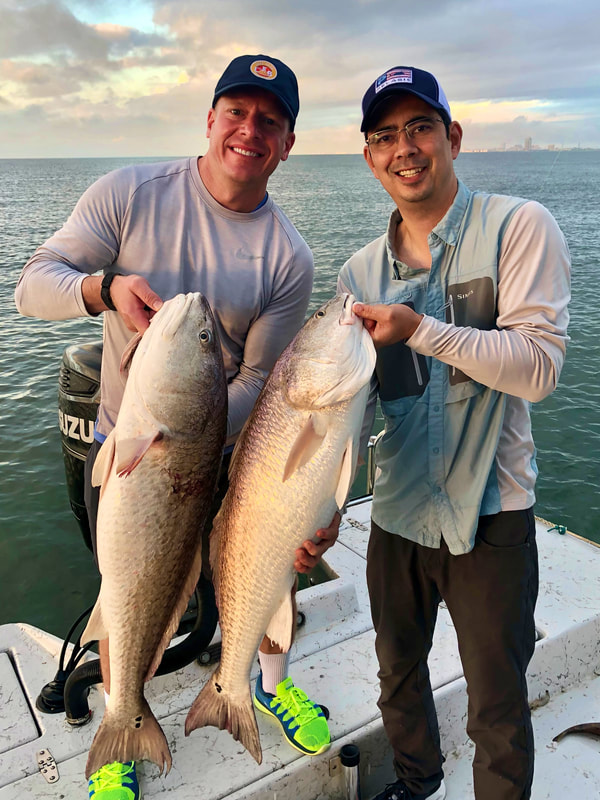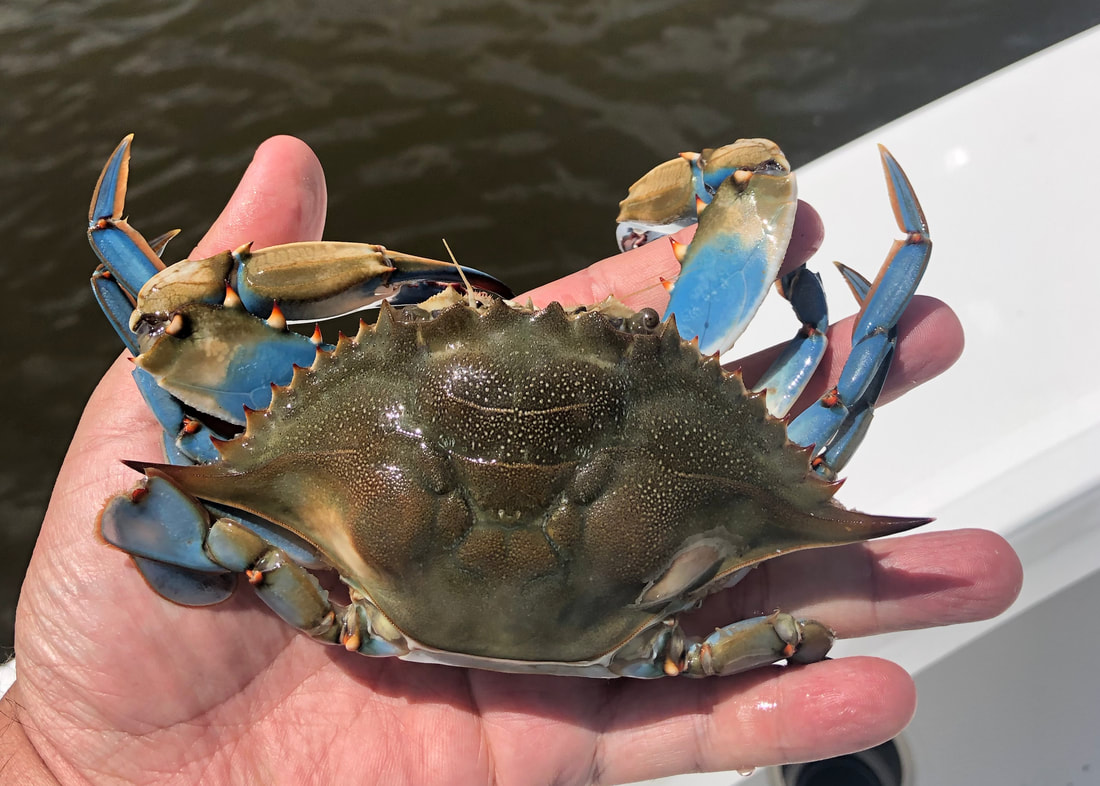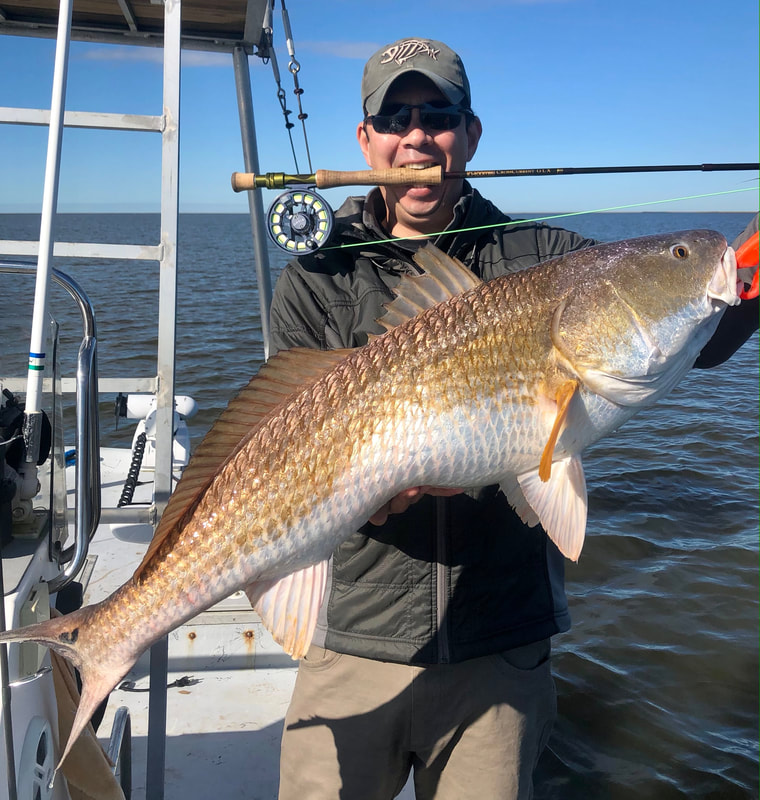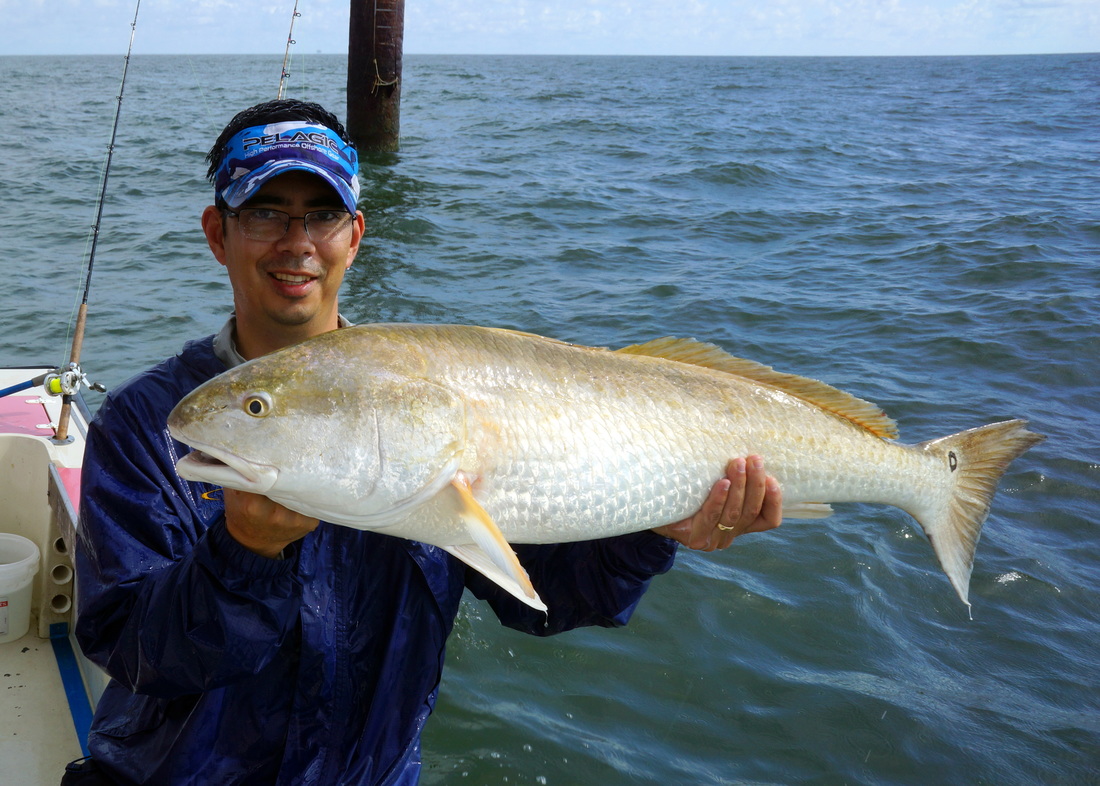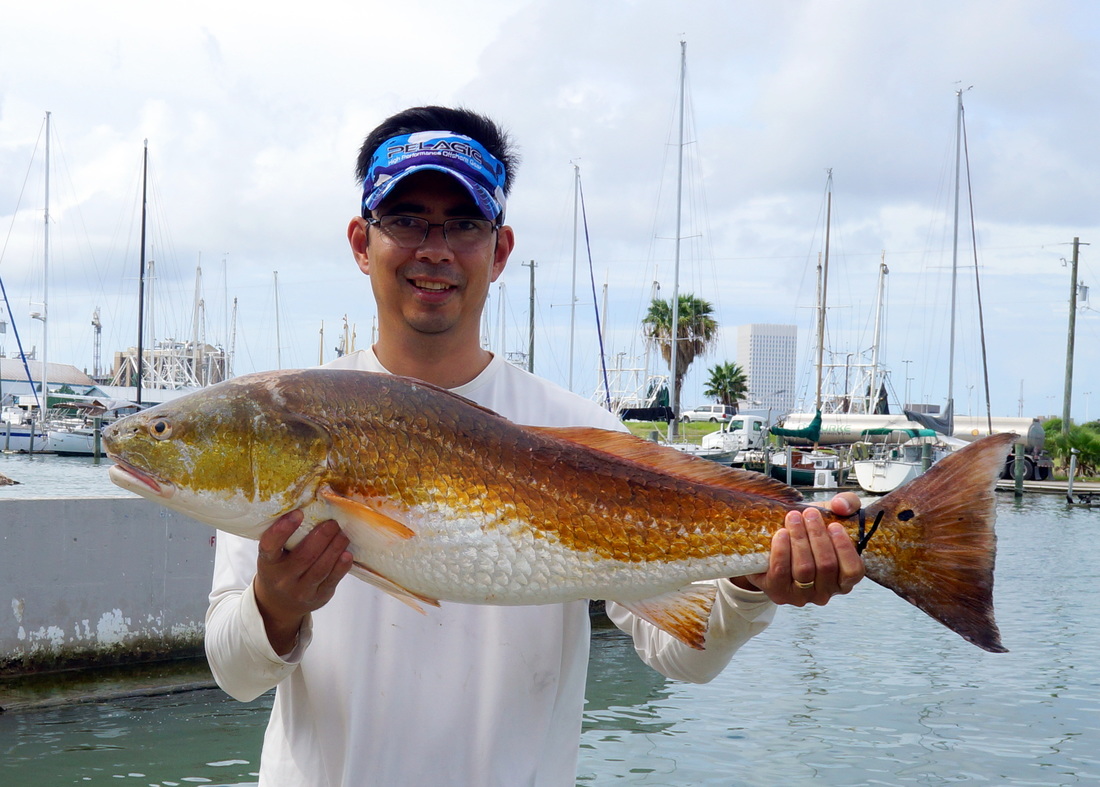Redfish
Sciaenops Ocellatus
Home
Other Species
Redfish Description
Redfish, also known as Red Drum, Channel Bass, or Spottail Bass, are a popular gamefish found along the Gulf Coast and parts of the Atlantic Coast of the United States. They are a hardy fish that can withstand a wide range of temperatures and environments. This makes them catchable year-round in pretty much all the places they are found. They can even live in freshwater and frequently swim up tidal creeks and rivers.
Redfish are a member of the Drum family and may make a characteristic grunting/drumming sound when pulled out of the water. They sometimes interbreed with their cousin the Black Drum. Their coloration ranges from almost silver to a bright coppery red (see pics at the bottom for some examples).
Redfish prey on crustaceans such as shrimp and crabs as well as many species of baitfish such as mullet, pinfish, lizardfish, etc. They happily pounce on a wide range of live and dead baits as well as artificial lures. They are often a good candidate for sight fishing when they are shallow, sometimes “tailing” with their noses down and tails out of the water while feeding. They are also frequently caught in the surf and off of jetties, making them very accessible to a wide range of anglers.
Many states have a size limit (often a slot limit) to help ensure that large females are able to breed and keep populations healthy. Fish above this limit are often referred to as bull redfish. Redfish top out at around 100lbs but fish even half that size are very rare.
Redfish are fairly easy to handle since they don’t have any large spines or teeth. They survive release well, although they may need to have their air bladders punctured with a needle if they swell up when taken from the bottom.
Redfish Pound for Pound Fight Rating - 6 out of 10 on the Saltwater Scale
Redfish put up a solid tussle, with some bulldogging towards the bottom and some long runs, especially from the larger ones. They don't really jump or head for cover, and you can land some very large ones on light tackle if you have some patience and wait for them to tire. For the bigger ones, heavy tackle is a plus in lifting them, especially in deeper water or near structure.
Redfish Culinary Rating - High
Redfish are an important food fish throughout the southern United States. The smaller ones are very tasty. They are on restaurant menus frequently. Many like to eat them blackened "on the half shell" with the skin still on. The big ones, over 36" or so, can be kind of tough.
Redfish Tackle
Redfish are often found near rocks or oyster beds, so it pays to use a fluorocarbon leader of 20-50lbs to help avoid breakoffs. They are not particularly line-shy. You can catch some very large ones on relatively light tackle, especially when they are found in shallow water away from structure. Largemouth Bass tackle, especially things that will stand up to saltwater corrosion, is sufficient in many situations. The redfish pictured above was caught on a light rod meant for much smaller fish. You do need some line capacity as the bigger ones can go on some fairly long runs if not turned. For big bull reds near rocks, you might consider going a bit heavier. Below are some suggestions for tackle.
Sciaenops Ocellatus
Home
Other Species
Redfish Description
Redfish, also known as Red Drum, Channel Bass, or Spottail Bass, are a popular gamefish found along the Gulf Coast and parts of the Atlantic Coast of the United States. They are a hardy fish that can withstand a wide range of temperatures and environments. This makes them catchable year-round in pretty much all the places they are found. They can even live in freshwater and frequently swim up tidal creeks and rivers.
Redfish are a member of the Drum family and may make a characteristic grunting/drumming sound when pulled out of the water. They sometimes interbreed with their cousin the Black Drum. Their coloration ranges from almost silver to a bright coppery red (see pics at the bottom for some examples).
Redfish prey on crustaceans such as shrimp and crabs as well as many species of baitfish such as mullet, pinfish, lizardfish, etc. They happily pounce on a wide range of live and dead baits as well as artificial lures. They are often a good candidate for sight fishing when they are shallow, sometimes “tailing” with their noses down and tails out of the water while feeding. They are also frequently caught in the surf and off of jetties, making them very accessible to a wide range of anglers.
Many states have a size limit (often a slot limit) to help ensure that large females are able to breed and keep populations healthy. Fish above this limit are often referred to as bull redfish. Redfish top out at around 100lbs but fish even half that size are very rare.
Redfish are fairly easy to handle since they don’t have any large spines or teeth. They survive release well, although they may need to have their air bladders punctured with a needle if they swell up when taken from the bottom.
Redfish Pound for Pound Fight Rating - 6 out of 10 on the Saltwater Scale
Redfish put up a solid tussle, with some bulldogging towards the bottom and some long runs, especially from the larger ones. They don't really jump or head for cover, and you can land some very large ones on light tackle if you have some patience and wait for them to tire. For the bigger ones, heavy tackle is a plus in lifting them, especially in deeper water or near structure.
Redfish Culinary Rating - High
Redfish are an important food fish throughout the southern United States. The smaller ones are very tasty. They are on restaurant menus frequently. Many like to eat them blackened "on the half shell" with the skin still on. The big ones, over 36" or so, can be kind of tough.
Redfish Tackle
Redfish are often found near rocks or oyster beds, so it pays to use a fluorocarbon leader of 20-50lbs to help avoid breakoffs. They are not particularly line-shy. You can catch some very large ones on relatively light tackle, especially when they are found in shallow water away from structure. Largemouth Bass tackle, especially things that will stand up to saltwater corrosion, is sufficient in many situations. The redfish pictured above was caught on a light rod meant for much smaller fish. You do need some line capacity as the bigger ones can go on some fairly long runs if not turned. For big bull reds near rocks, you might consider going a bit heavier. Below are some suggestions for tackle.
Redfish Techniques
Looking at their mouths, you would think that Redfish only feed on the bottom, but surprisingly they will readily take topwater lures in certain situations. They often get into extremely shallow areas, and sometimes give themselves away by having their tails or backs visible out of the water. You can often sight fish for them, and when they are deeper bottom fishing with live or dead bait is very effective. They are not particularly choosy and will accept a wide variety of lures and baits.
Redfish Bait
Redfish take a wide variety of dead and live baits. Live shrimp and croakers work well, while large dead baits such as mullet heads and whole shad and blue crab are all good bets for the larger ones when soaked on the bottom. In general, the larger ones tend to feed more on fish than shrimp, so if you are looking for bull reds I would go with some sort of fish.
Redfish Lures
Popular Redfish lures include gold spoons like the Johnson Minnow Spoon, spinnerbaits, topwaters like the Heddon Zara Spook and Mirrolure Top Dog, and Berkley Gulp shrimps fish on a jighead. The spoons and spinnerbaits can be fished on a straight retrieve, while the topwaters should be worked by "walking the dog" and pausing now and again. Strikes often come on the pause. The plastics are generally best fished by bouncing them off of the bottom. When the fish are shallow, it's hard to beat a white Gulp Shrimp on a 1/4 oz jighead.
If you are fishing in murky water, try a Chatterbait in a bright color with a plastic craw trailer.
Redfish on Fly
Redfish can readily be caught on a variety of flies, especially when schooling. When you find feeding schools, almost any fly resembling what they are eating (typically shrimp or small fish) will work. You can also sight fish single fish in some areas. In Louisiana, for instance, there is a great winter fishery for Bull Redfish in the shallows when the weather cooperates enough for you to see them. A fast sinking fly is the ticket for these winter bulls. Let it sink a few feet in front of them and make some small strips to trigger them to bite. An 8wt is a good choice for the bulls as it is light enough to cast easily but heavy enough for the bigger fish.
Where to get the big Redfish
Texas and Louisiana have an abundance of big Redfish. You don’t even have to get far from major population centers such as Houston or New Orleans to get them, which is nice.
Other Redfish Resources
Click on the Amazon links below for books I have found helpful and also lures that will catch you Redfish.
If you want to catch Redfish in the Galveston Bay area, give Capt Ryan Battistoni a call: www.fishgalvestonbays.com
If you want to flyfish for Redfish in Texas or Louisiana, give this guy a call: http://www.castingtales.com/
http:www.ellendercharters.com
Slot-Sized Redfish Photos. Note the color variations:
Bull Redfish Gallery:
